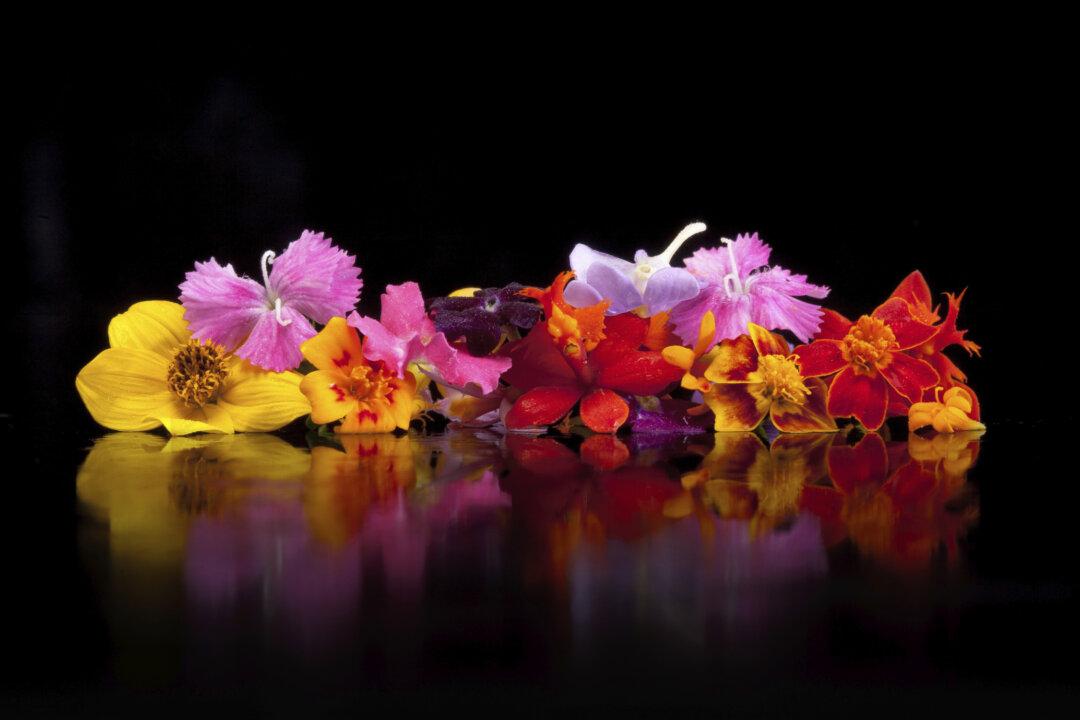You might not realize it, but flowers are part of many people’s daily fare. Eating flowers probably started because of food shortages, as it did in China, where there was and probably still is not only a scarcity of arable land but a huge variety of wild foods. Eating the roots of water lilies and making cakes of their seeds was common in ancient times, as was eating a soup made from wisteria blossoms.
In Canada today, many people eat flowers without realizing it. Think of capers, the flower buds of a Mediterranean plant; saffron, the golden stigmas of the autumn crocus; and cloves, the small flowerets of evergreen trees. But many garden flowers are also edible, such as roses, carnations, and nasturtiums, all with the bitter white part at the centre removed and all unsprayed, of course. Wild violets are also delicious, especially in an endive salad.
Here are some recipes using flowers:
Salade Olivier (A Russian specialty named for a French chef)
Makes 6 servings
- 1 1/2 kg (3-lb) roasted chicken
- 4 boiled potatoes, peeled and sliced
- 4 hard-boiled eggs, cut in quarters
- 2 dill pickles, in thin slices
- 125 ml (1/2 cup) sour cream
- 175 ml (3/4 cup) mayonnaise
- Salt and pepper to taste
- Hearts of lettuce
- 50 ml (2 tbsp) capers
- Garnish of olives and sliced tomatoes
Cube the chicken and mix with the potatoes and the eggs. Add the mayonnaise, pickles, and sour cream. Season to taste. Serve on a bed of lettuce and garnish with capers, olives, and tomatoes.
Peris in Syrippe (12th century English recipe)
Makes 6 servings
- 6 very hard pears
- 150 ml (2/3 cup) sugar
- 1/2 to 1 bottle dry red wine
- Strip of dried orange rind
- 6 to 8 cloves
- Pinch of ginger
- 4 to 5 threads saffron (optional)
- 1 stick cinnamon
Peel the pears, leaving them whole with stems on. Stand upright in a narrow earthenware casserole, then add sugar and enough wine to cover pears half way. Add remaining ingredients and enough water to completely cover the pears. Cover casserole and bake in a preheated 120º C (250º F) oven for 5 to 7 hours, turning pears from time to time as liquid cooks down. Bake until pears are tender but not falling apart and liquid becomes like syrup. Cool in the syrup. Remove the cloves, cinnamon stick, and orange peel, and serve with unsweetened whipped cream.
Egyptian Sweetmeat
Makes 6 servings
- 425 ml (1 3/4 cups) sugar
- Juice of half a lemon
- 25 ml (2 tbsp) rose water
- 6 cakes shredded wheat, crumbled
- 750 ml (3 cups) walnuts, coarsely ground
- 150 ml (2/3 cup) butter, melted and cooled
Combine 375 ml (1 1/2 cups) sugar and 125 ml (1/2 cup) water in a heavy-bottomed saucepan. Bring to a boil and simmer until sugar spins a thread. Add lemon juice and simmer five more minutes. Add 15 ml (1 tbsp) rose water and cool. Set aside. Add half the butter to the nuts and mix with remaining sugar and rose water.
Butter a 20 x 20 cm (8 x 8-inch) cake pan. Place a layer of shredded wheat on the bottom and then cover with half the nuts. Repeat twice, ending with a layer of shredded wheat. Pour on remaining butter and bake in a preheated 220º C (425º F) oven for 10 minutes, then reduce heat to 190º C (375º F) and bake for 20 to 25 minutes. Pour the cooled syrup over and cool. .
Susan Hallett is an award-winning writer and editor who has written for The Beaver, The Globe & Mail, Wine Tidings, and Doctor’s Review, among others. She is currently the European editor of Taste & Travel International. Email: [email protected]





